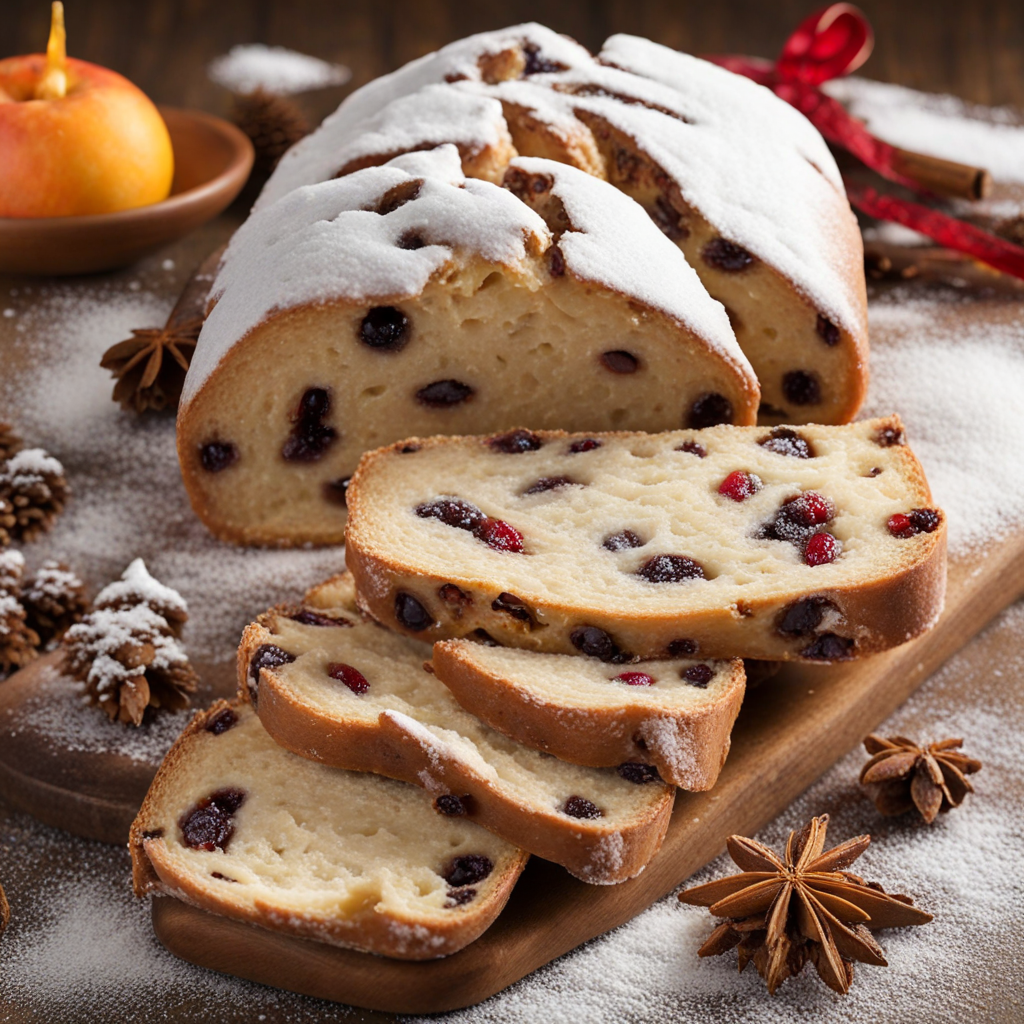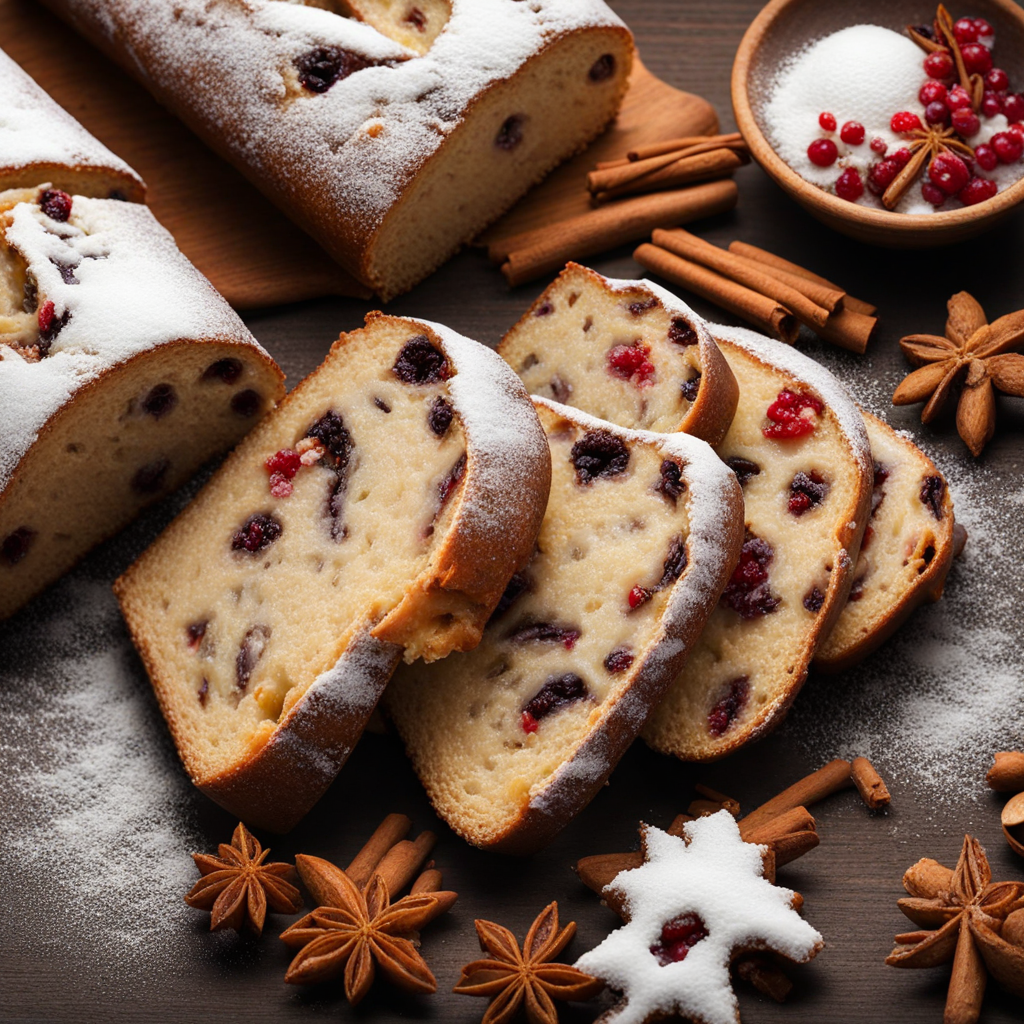Stollen
Stollen is a traditional German bread-like cake that embodies the spirit of the festive season, particularly during Christmas. This delightful treat is characterized by its dense, moist texture and a rich medley of flavors. The dough is typically made with a combination of flour, butter, sugar, and yeast, which creates a soft and tender crumb. What makes Stollen truly special is its generous filling of dried fruits, such as raisins, currants, and candied citrus peel, which infuse each slice with a burst of sweetness and a hint of tartness. Often, a touch of warm spices like cinnamon and nutmeg is added, enhancing the overall aromatic experience. One of the most distinctive features of Stollen is its marzipan center, a sweet almond paste that adds a luxurious creaminess to each bite. This signature element not only contributes to the flavor profile but also provides a delightful contrast to the fruit-laden dough. Once baked, the Stollen is usually brushed with melted butter and dusted with powdered sugar, giving it a snowy appearance that is reminiscent of winter and holiday cheer. The visual appeal of the cake, combined with its rich flavors, makes it a centerpiece for festive gatherings. Traditionally, Stollen is best enjoyed after it has had a chance to rest for a few days, allowing the flavors to meld and mature. As it ages, the moisture from the dried fruits seeps into the crumb, making it even more delectable. It is commonly served in thick slices, often accompanied by a steaming cup of coffee or tea, making it a perfect accompaniment for cozy gatherings. Whether you are celebrating the holiday season or simply looking to indulge in a new taste experience, Stollen is a delightful journey into German culinary tradition that is sure to enchant your palate.
How It Became This Dish
The History of Stollen: A German Culinary Delight Stollen is a traditional German fruitcake, rich in flavor and steeped in history, primarily associated with the Christmas season. Its origins can be traced back to the 14th century, though the cake has undergone numerous transformations throughout the centuries, reflecting the cultural and historical shifts in Germany. Origins The earliest forms of Stollen can be found in the city of Dresden, where it was first mentioned in 1329. The cake emerged during a time when baking was heavily influenced by the religious practices of the region. In the Middle Ages, fasting was a significant part of the Christian calendar, and butter—an essential ingredient in many baked goods—was prohibited during Lent. To compensate for this, bakers began to use a mixture of flour, yeast, and water to create a denser, bread-like cake. Initially, these early Stollen were rather plain and did not yet possess the rich flavors that characterize the modern version. The cake was often referred to as "Striezel," a term derived from the German word meaning "to twist," which is reflective of the shape that the dough would take during preparation. The Influence of the Reformation A pivotal moment in the history of Stollen came during the Reformation in the early 16th century. In 1520, Martin Luther, a key figure in the Protestant Reformation, referenced Stollen in a letter, signifying its growing importance in German culture. The cake became associated with Christmas celebrations, symbolizing the birth of Christ. It was often baked as a gift for the church, and its shape began to take on a more symbolic representation of the Christ child wrapped in swaddling clothes. Around this time, the use of spices and dried fruits began to be incorporated into the Stollen recipe, reflecting trade routes that brought exotic ingredients to Europe. The addition of marzipan, nuts, and candied fruits not only enriched the flavor but also turned Stollen into a luxurious treat that was highly sought after during the festive season. The Birth of the Dresden Stollen As Stollen evolved, the city of Dresden became its epicenter. The first documented recipe for the modern Stollen appeared in 1730, and the cake was officially recognized as a specialty of the city. The Dresden Stollen, or "Dresdner Stollen," became famous for its unique composition, which included a generous amount of butter, a variety of dried fruits, spices, and a dusting of powdered sugar to resemble snow. The Dresden Stollen was so revered that in 1900, the city established a festival called the "Dresden Stollen Festival," celebrating the cake's cultural significance. This annual event features a grand parade, where a giant Stollen is baked, and portions are distributed to attendees, reinforcing the cake's role as a symbol of community and festivity. Stollen and Cultural Significance Stollen is more than just a holiday dessert; it represents a rich tapestry of German history and tradition. In many German households, baking Stollen is a cherished ritual that occurs during Advent, the period leading up to Christmas. Families often pass down their recipes through generations, each adding a personal touch to the cake. The act of making Stollen serves as a way to connect with cultural roots and create lasting memories. The cake's symbolism extends beyond culinary traditions. Its shape and ingredients have come to embody the spirit of giving and togetherness during the Christmas season. Stollen is often exchanged among friends and family, with the act of sharing the cake reinforcing communal bonds. In this way, Stollen has transcended its status as a mere dessert; it has become a symbol of love, generosity, and the joy of the holidays. The Modern Era and Variations As the 19th and 20th centuries rolled in, Stollen continued to adapt and evolve. During this period, industrialization and advances in baking technology made it easier to mass-produce Stollen, allowing it to reach a broader audience both within Germany and abroad. This led to the emergence of various regional variations, each with its own distinct characteristics. In addition to the traditional Dresden Stollen, other popular types include the "Bamberg Stollen," which incorporates local spices, and the "Thuringian Stollen," known for its moist texture and rich flavor. Furthermore, as globalization took hold, Stollen began to appear in international markets, introducing new audiences to this beloved German delicacy. Today, Stollen is often enjoyed not only during Christmas but throughout the year. Many bakeries and families still adhere to the traditional recipes, while others experiment with modern twists, incorporating ingredients like chocolate, or creating gluten-free versions to accommodate dietary preferences. The Importance of Quality In recent years, there has been a push for authenticity and quality in Stollen production. Many bakers now emphasize the use of high-quality ingredients, including organic flour, real butter, and premium dried fruits. The annual "Dresdner Stollen Protection Association" works to safeguard the traditional recipes and craftsmanship associated with the Dresden Stollen, ensuring that it remains a cherished part of German culinary heritage. Conclusion Stollen represents a rich history that intertwines with Germany's cultural and religious traditions. From its humble origins as a simple bread meant to sustain during fasting to its status as a luxurious holiday treat, Stollen has evolved into a symbol of joy, community, and the holiday spirit. Its enduring popularity reflects not only its delightful taste but also the deep-rooted customs and memories that it evokes, making it an integral part of Germany's festive celebrations. As families continue to bake and share Stollen, they carry forward a legacy that connects past and present, ensuring that this delicious cake will be enjoyed for generations to come.
You may like
Discover local flavors from Germany







